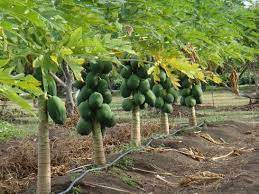Papaya (Carica papaya L.)
Climate: Papaya is very sensitive to frost. Papaya prefers warm climates with abundant rainfall or irrigation. Temperatures range from 21°C to 33°C is ideal for sturdy growth but higher temperature can be tolerated with adequate soil moisture and not too low relative humidity.
Soil: The pH value of 6 and 6.5 is suitable. The sandy loam soil with adequate organic matter is most important for the papaya cultivation. In a high rainfall area, if drainage is poor and roots are continuously drenched for 24 to 48 hours, it may cause the death of the plants. Sticky soils are not good as rainwater may accumulate in the soil in a few hours.
Sex variation: The papaya plant is normally unisexual. Either they are male or female occasionally, a plant with hermaphrodite flowers may occur. The proportion of fruit-bearing female plants of any variety varies from 40 to 60 percent. Coorg Honey Dew variety of papaya have female or hermaphrodite hence, every plant yield fruits.
Varieties: Honey Dew, Coorg Honey Dew, Washington, Solo, Co-f, Co-2, Co-3, Sunrise Solo, Taiwan selection, Honey Dew, Pusa Delicious, Pusa Nanha (dwarf), Coorg Honey Dew, Coorg Green, etc.
Propagation: Papaya is propagated with seeds. Seed should be rubbed with ash from cattle dung to remove the mucilaginous coating. The seed is treated with captan or season sowed about 1 cm deep in a well-prepared raised bed about 15-20 cm above the ground level. The seed should be planted 2-3cm apart, in rows 7-8cm apart.
Land preparation: Plowed and harrowed twice. An elevated plot along the row is made by plowing on barring with two passes on each side. This will ensure proper irrigation and drainage. Organic fertilizer and manure should be spread and incorporated into the soil during land preparation.
Manure and fertilizer: Well decomposed FYM @ 10 kg/plant) applied in the pits, 200-250 gm each of N. P205 and K20 are recommended for getting high yield during transplanting. Application of 200 gm Nitrogen is best for fruit yield but papaya yield increases with an increase in N up to 300 g.
Seed requirement: One gram contains mostly 65 -75 seeds. It needs 50 to 80 gm seeds per hectare with average of 80 % seed germination and 80% successful seedlings.
Planting: When the seedling is 10 -15 cm tall it should be transplanted. A spacing of 1.8 x 1.8 m is normally followed. Higher density cultivation with a spacing of 1.5 x 1.5 m/ha enhances the returns to the farmer. Closer spacing of 1.2 x 1.2 m. for cv. Pusha Nanha is adopted for high-density planting, total of 6,400 plants/ha can be planted. In the absence of hermaphrodite plants, one male plant per 25-100 female plants is retained as a pollinator.
Intercultural operations: Deep hoeing in the first year to check weed growth. Weeding should be done regularly especially around the plants. Application of Fluchloralin or Alachlorin or Butachlorine (2.0 gm/ha.) as pre-emergence herbicide two months after transplanting can effectively control the weeds for four months.
Irrigation: Normally, irrigate every 15 days in winter or 10 days in summer, but practice varies according to the soil, climatic conditions, and irrigation methods. Irrigation helps to prevent the flower or fruit drop. Ring irrigation, furrow and drip irrigation can be done. However, prevent the water from coming in contact with the stem.
Harvest: Fruits are harvested when they become full size, light green with a tinge of yellow at the apical end. On ripening, fruits of certain varieties turn yellow and other may remain green. When the latex changes from milky to watery, the fruits are suitable for harvesting. The economic life of a papaya plant is only 3 to 4 years. The yield varies widely according to the variety, soil, climate, and management of the orchard. The yield of 75-100 ton/ha is obtained in a season from a papaya orchard depending on spacing and cultural practices and variety.
